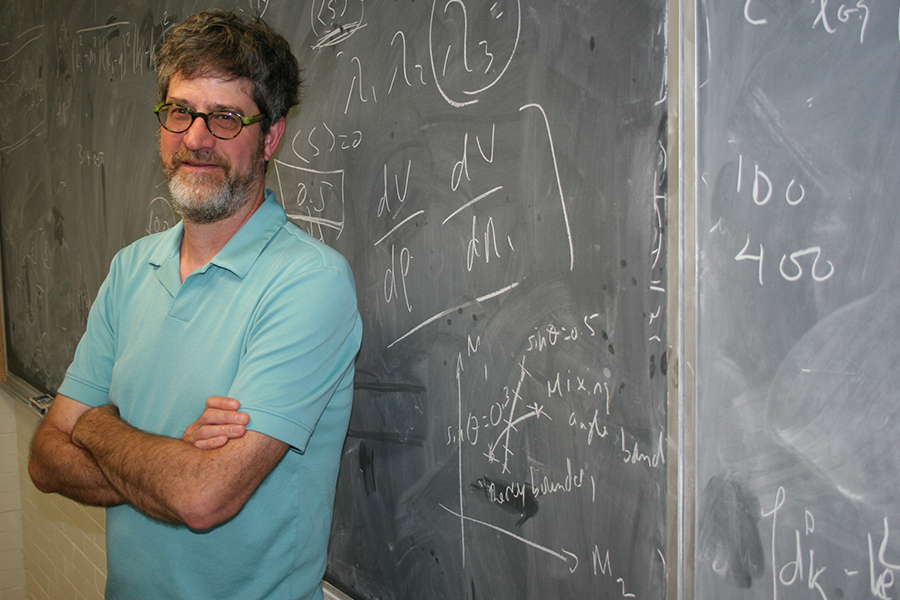
Art and science at the foundations of the universe
At the very foundations of the universe, where even atoms are huge, there lies a bewildering menagerie of oddly named particles like leptons and quarks, baryons and gluons, and of course, the famous Higgs boson, all of which should be beyond our comprehension—but they’re not.
By Michael RobinAs Tom Steele explained it, mathematics can encompass concepts impossible to express in any spoken tongue. Even the way that it is read differs from regular language, seeming to draw on both the logical areas of the brain as well as those more attuned to art.
"It amazes me that we can use mathematics to describe the physical world," said Steele, a theoretical particle physicist and head of the Department of Physics and Engineering Physics.
"I don't see any reason why this should be. Why should we even be able to formulate the complexity of the universe and physical phenomena with mathematics?"
To illustrate, he pulls a substantial-looking hardcover book from the shelf lining a wall of his office. He flips it open to a page covered with short paragraphs of English text sandwiched between much longer dense blocks of complex mathematical symbols. These describe concepts in graduate-level quantum mechanics.
Steele explained these blocks of math are not read left-to-right, top-to-bottom, like text. Rather they are read both as individual elements and as a whole, similar to how an art aficionado would take meaning from a painting.
The art analogy is also used in his own specialty, the exotic particles within the field of quantum chromodynamics (QCD). Here, quarks are assigned colours—a useful way to understand how their various charges "mix" together to form larger particles.
"Quarks are not literally red and green and blue, but it's a good concept to describe how the actual charges come together," he said. "The underlying mathematics is a lot like the phenomena of colour, so that's why it's used."
Steele is particularly interested in the idea of colour confinement—that is, anything in nature should be made up of combinations of three "colours" of quarks (actually three colours and three "anticolours," since each quark has an antimatter cousin). An analogy would be a painter only being able to create certain hues from a limited set of starting pigments.
"Once you have the idea of colour confinement, there are a whole bunch of different things you can do," Steele said, citing various odd combinations of quarks and even "glueballs" which are conglomerations of pure gluons.
"I've been chasing those particles—they're called exotics— all my working career," he said. A prolific researcher, Steele has been continuously funded through the Natural Science and Engineering Research Council for more than 25 years, producing more than 100 papers. The most recent, which came out in July, was inspired by an experiment at the Large Hadron Collider aimed at shedding light on why the universe is composed almost entirely of matter but almost no antimatter.
"It's one of the big unanswered questions in physics," Steele said. "Why is the universe dominated by matter instead of antimatter? There's a clear imbalance in the universe, it's a big question and it's unresolved." It's the type of fundamental question that has kept Steele engaged for decades.
"Why shouldn't we know what matter is ultimately made of?" he said. Steele suggested starting with something easily understood, like a table. We understand its chemistry, that is, what molecules the table is made of, and even the atoms that comprise those molecules. But beyond that, things become less certain.
"That leads us to all sorts of other questions, like how neutrons and protons interact with electrons, how quarks interact with each other—what are the basic principles of that that make matter the way it is?" Steele said.
One of the latest big questions in Steele's mind is dark matter. Little is known about it, but astronomers observe gravitational forces in deep space where they can otherwise see nothing. Something invisible is pulling on the regular matter. Steele hopes theoretical particle physics might provide a clue to this mystery of the universe.
"The Higgs (boson) is supposed to impart mass to matter, and we know dark matter also has mass," he explained. "Because of this, we're hoping the Higgs might give us a window into dark matter."

